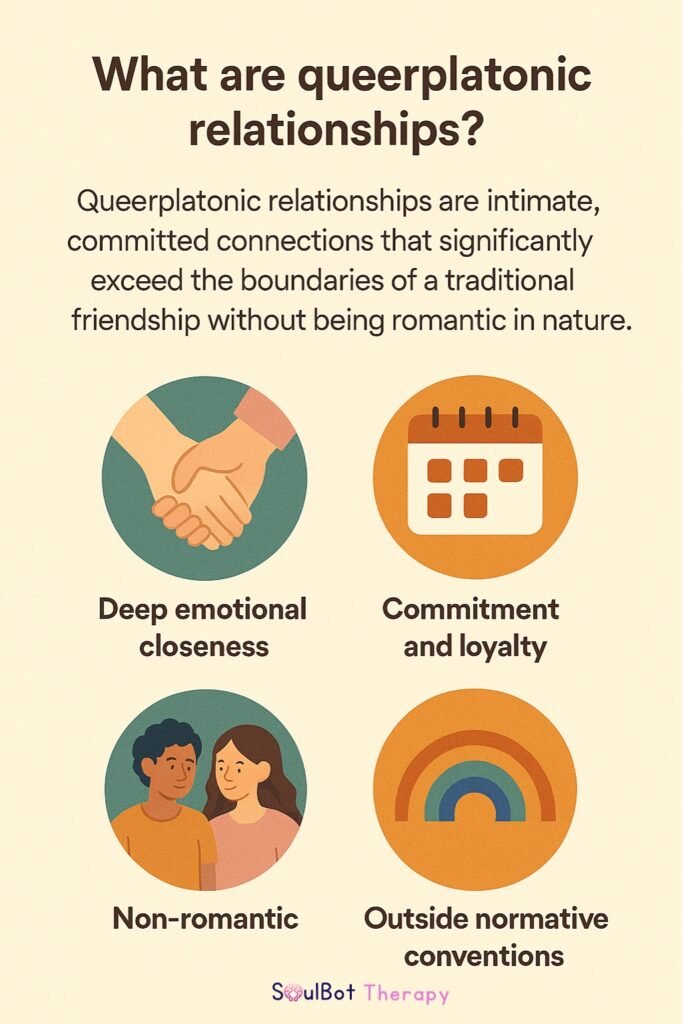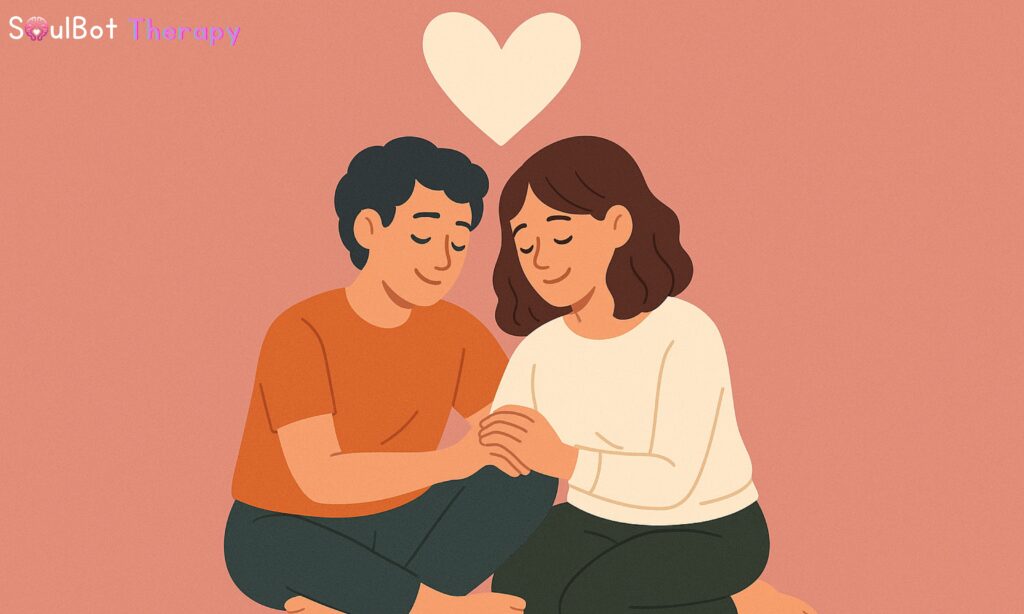A queerplatonic relationship (QPR) is a deeply committed, non-romantic partnership that might look like a traditional romantic relationship without the romance. It goes beyond friendship but doesn’t necessarily involve romantic or sexual attraction.
People in queerplatonic relationships might:
- Live together
- Share finances
- Raise children
- Consider each other as life partners
This means that emotional closeness doesn’t have to be romantic to be real. It’s a valid, intense bond that challenges how we’ve been told love “should” look.

🧠 Explore Your Emotional Needs with SoulBot
Not sure how you connect with others beyond romance? SoulBot’s AI therapy assistant helps you unpack emotional intimacy, relationship roles, and personal boundaries judgment-free.Why Do People Choose Queerplatonic Relationship/Partnerships?
Because not everyone’s emotional wiring fits neatly into romance vs. friendship.
People, especially those who identify on the asexual or aromantic spectrum, may feel deep platonic intimacy that society doesn’t quite know how to label. That’s where queerplatonic relationships come in.
And here’s the thing: you don’t have to be asexual or aromantic to be in one. QPRs are open to anyone who wants a deep, committed connection without the expectations of romance.
What Does a Queerplatonic Relationship Look Like in Real Life?
The truth? There’s no fixed blueprint. That’s the point.
Some examples:
- Two best friends who raise a child together
- Life partners who sleep in the same bed but aren’t sexually involved
- Chosen family that treats each other as primary partners in life
It’s all about intention, not labels. The connection matters more than the mold it fits.
How Is It Different from Friendship or Romance?
Here’s a simple breakdown:
| Type of Bond | Emotional Depth | Physical Affection | Romantic Involvement | Social Recognition |
|---|---|---|---|---|
| Friendship | Medium to high | Optional | No | Widely accepted |
| Romantic | High | Common | Yes | Highly validated |
| Queerplatonic | Extremely high | Optional | No | Often misunderstood |
So, if you’re asking, “Is this just a really intense friendship?”, the answer is: not exactly. Queerplatonic relationships exist on their own part of the relationship spectrum.
💬 Take the Love Language Test
Your platonic connections matter too. Discover how you best give and receive care even outside romantic relationships.Are Queerplatonic Relationships Part of LGBTQ+ Dynamics?
Absolutely. QPRs often exist in LGBTQ+ communities because they challenge conventional ideas of love, gender roles, and emotional closeness.
They:
- Support queer identity expression
- Center chosen family structures
- Offer safe, emotionally rich connections outside heteronormative scripts
But again, anyone, queer or not, can choose this kind of bond.
🧠 SoulTip: According to a paper in the Journal of Homosexuality, queerplatonic partnerships represent a significant evolution in how we define relationships, especially for those who identify on the aromantic spectrum.
How Do You Know If You’re in a Queerplatonic Relationship?
You don’t need a rulebook, but some signs include:
- You prioritize this person as a life partner
- You feel more intimacy than with typical friends
- You talk about life goals, care work, or shared future plans
- You both reject romantic labels but still see each other as “your person”
The biggest marker? Mutual agreement. A QPR starts when people recognize and affirm their connection as more than friendship.
How Do You Communicate and Set Boundaries in QPRs?
Like every relationship, straightforward, honest, and ongoing communication is everything.
- ✅ Talk about physical affection boundaries
- ✅ Discuss emotional needs and expectations
- ✅ Set agreements for cohabitation, finances, or shared goals
- ✅ Respect each other’s evolving identities
📚SoulFact: Psychology Today notes that “chosen family and queerplatonic bonds offer vital emotional support and stability,” especially for LGBTQ+ individuals facing systemic barriers to traditional relationship models.
Remember: Queerplatonic relationships don’t come with a default settings menu. You build it together.
How Can Society Support These Relationships?
It starts with visibility. Most medical, legal, and financial systems prioritize romantic and marital partnerships. That leaves queerplatonic partners invisible in:
- Hospital visitation rights
- Housing applications
- Insurance benefits
What we need is broader recognition of relationship diversity. Emotional bonds don’t need a ring or romantic history to matter.
Final Thoughts
Queerplatonic relationships are real, meaningful, and deserving of recognition. They offer a form of love that’s not romantic or sexual but as profound, valid, and life-changing.
So whether you’re curious, already in one, or exploring your identity, know this: there’s no one right way to love or be loved.
Let your relationship define itself and trust that it matters.
🔗Related Reads
- How to Build Emotional Intimacy in a Relationship?
- Relationship Green Flags: 7 Signs You’re Building It Right
- Relationship Growth Checklist: Are You Growing Together or Apart?
- Relationship Red Flags You Should Never Ignore
- Conflict Resolution in Relationships: Strategies That Actually Work
- Relationship Trauma: How Your Past Shapes the Way You Love
- How to Rebuild Trust in Relationships After Betrayal?








